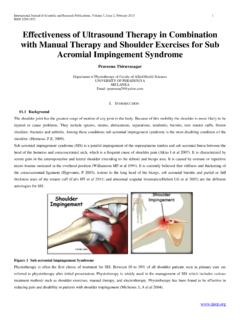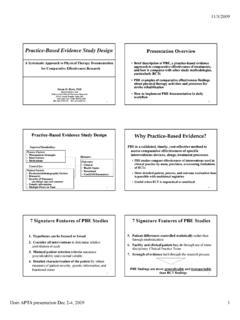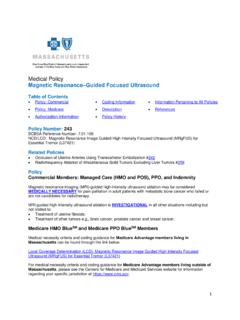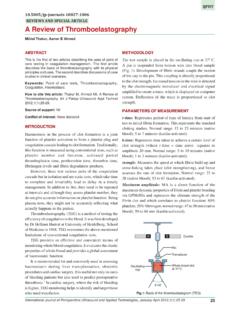Transcription of MRI Guidelines for VNS Therapy® - epilepsieliga.nl
1 MRI Guidelines for VNS therapy MRI can be safely performed on patients with VNS therapy provided that specified Guidelines are new MRI labeling allows patients with an implanted VNS therapy System to receive fast and high quality scans also with use of Body Coils*. *only for Aspire HC Model 105 or AspireSR Model 106 with scan conditions as listed on page 221 Performing MRI with a body coil is safe when the below conditions are followed: Safe MRI Conditions with the usage of Transmit Body CoilMRI Guidelines for VNS therapy No local transmit-receive coil requiredPermissable Scan AreaMRI Exclusion ZoneMR ConditionalYesStatic Magnet or 3 TScanner TypeHorizontal field, cylindrical closed-bore or 3T scannerOperating ModeNormal Operating ModeExclusion ZoneBody coil.
2 C7-L3 Transmit-receive head or extremity coil: C7-T8 Max Spatial Gradient 3000 Gauss/cmMax Slew Rate200 T/m/sRF CoilTransmit: Body coil or Transmit-receive head or extremity coils Receive: No RestrictionsMax SART ransmit head coil: W/kg Transmit body coil: W/kgSystem ProgrammingStimulation OFF Sensing OFF**for select models with AutoStim modeExposure TimeTransmit head or extremity coil: No restrictionsTransmit body coil: 15 minutes of active scan time within a 30 minute windowAdditional RestrictionsTransmit head or extremity coil: noneTransmit body coil: Circularized Polarized mode onlyMR of all MRI scans performed onpeople with epilepsy%Any MRI center close byof brain MRII maging techniques such as computed tomography, x-ray, and ultrasound are safe to perform in the MRI exclusion the most current labelling prior to performing an MRI scan.
3 For full MRI safety information, refer to MRI Instructions for Use at Patients with implants in other locations must follow alternate scan conditions as listed on page 4 Aspire HC Model 105 or AspireSR Model 106 and the generator location according LivaNova implanting Guidelines in the upper left chest at or above armpit (above rib 4) % 100 GROUP A43 Performing MRI with a transmit-receive coil is safe when the below conditions are followed: Safe MRI Conditions with Transmit-Receive Local CoilMRI Guidelines for VNS therapy Local transmit-receive coil requiredMR ConditionalYesStatic Magnet or 3 TScanner TypeHorizontal field, cylindrical closed-bore or 3T scannerOperating ModeNormal Operating ModeExclusion ZoneC7-T8 Max Spatial Gradient 3000 Gauss/cmMax Slew Rate200 T/m/sRF CoilTransmit-receive head or extremity coilsMax SART ransmit-receive head coil.
4 W/kgSystem ProgrammingStimulation OFF Sensing OFF**for select models with AutoStim modeExposure TimeTransmit-receive head or extremity coil: No restrictionsAdditional RestrictionsNoneMRMRI Exclusion ZonePulse Model 102, Pulse Duo Model 102R,DemiPulse Model 103, DemiPulse Duo Model 104 and AspireHC Model 105 or AspireSR Model 106 NOT located in the upper left chest, at or above armpit (above rib 4).Imaging techniques such as computed tomography, x-ray, and ultrasound are safe to perform in the MRI exclusion to extremity scans including knee, ankle, and wristaccessto brain MRIR eview the most current labelling prior to performing an MRI scan.
5 For full MRI safety information, refer to MRI Instructions for Use at scans include head, knee, ankle, and wrist% 100 GROUP B65 Lead Only 2cm remaining* Performing MRI is safe when the Guidelines below are followed: Special MRI scenarios* Equivalent to clipping the lead at the anchor tetherMRI Guidelines for VNS therapy Exclusion ZoneNoneMR ConditionalYesStatic Magnet or 3 TOperating ModeNormal Operating ModeMax Spatial Gradient 3000 Gauss/cmMax Slew Rate200 T/m/sRF CoilTransmit: Body or transmit-receive head or extremity coilsReceive: No RestrictionsMax SART ransmit head coil: W/kg Transmit body coil: W/kgMRMR ConditionalYesStatic Magnet or 3 TScanner TypeHorizontal field, cylindrical closed-boreOperating ModeNormal Operating ModeExclusion ZoneC7-T8 Max Spatial Gradient 3000 Gauss/cmMax Slew Rate200 T/m/sRF CoilTransmit-Receive head or extremity coils onlyMax SART ransmit-Receive head coil.
6 W/kgMRSuspected Lead BreakLead Only 2cm remaining OR87 Pre-MRI instructionsPre- and Post-MRI InstructionsAn appropriate healthcare professional with access to a VNS therapy programming system must prepare the VNS therapy generator before the patient enters an MR system Interrogate the VNS therapy generator and record the generator settings2. Perform System Diagnostics to ensure proper operation of the generator3. Reprogram the Output Current parameter settings for Normal Mode, Magnet Mode, and AutoStim Mode as follows: Output Current (mA): Magnet Current (mA): AutoStim Current (mA): and Event Detection OFF 4.
7 Interrogate the generator to verify that programming was successful5. Verify that placement of the VNS therapy system is located between the C7 and T8 vertebrae6. Instruct the patient to notify the MR system operator of pain, discomfort, heating, or other unusual sensations so the operator can terminate the procedure, if Guidelines for VNS therapy Post-MRI instructionsAfter the MRI procedure, an appropriate healthcare professional with access to a VNS therapy programming system should assess the condition of the VNS therapy assess the VNS therapy system:1.
8 Interrogate the VNS therapy generator2. If the generator was reset during the scan, reprogram the serial number, patient ID and implant date, as needed*3. Program the patient s therapeutic parameters as they were before the MRI procedure4. Perform System Diagnostics. Results should indicate Impedance = OK5. Interrogate the generator again to confirm that reprogramming was patients with Tuberous Sclerosis currently MRI is considered the modality of choice for the evaluation of the brain. Computer Tomography is the modality of choice for evaluating renal lesions.
9 1 To ensure effective communication with the MRI centre, complete the Patient MRI with the patient to their MRI appointment. Form can be downloaded at for select models with AutoStim mode* When an interrogation is performed by the programming software, the generator serial number, implant date, stimulation parameters, and generator operating time are automatically logged in the programmer database. This information may be retrieved from the database at any time after Summary* of Safety Information for the VNS therapy System[Epilepsy Indication] (July 2017)MRI Guidelines for VNS therapy INTENDED USE / INDICATIONS:Epilepsy (Non-US) The VNS therapy System is indicated for use as an adjunctive therapy in reducing the frequency of seizures in patients whose epileptic disorder is dominated by partial seizures (with or without secondary generalization) or generalized seizures that are refractory to seizure medications.
10 Model 106 AspireSR (Seizure Response) features the Automatic Stimulation Mode which is intended for patients who experienceCONTRAINDICATIONS: Vagotomy The VNS therapy System cannot be used in patients after a bilateral or left cervical Do not use short-wave diathermy, microwave diathermy, or therapeutic ultrasound diathermy on patients implanted with a VNS therapy System. Diagnostic ultrasound is not included in this arrhythmia (Model 106 only) The AutoStim Mode feature should not be used in patients with clinically meaningful arrhythmias or who are using treatments that interfere with normal intrinsic heart rate responses ( , pacemaker dependency, implantable defribrillator, beta adrenergic blocker medications).







